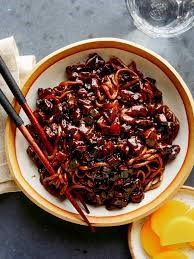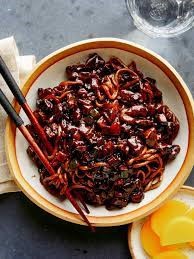Jjajangmyeon (자장면), often dubbed the “Korean black bean noodle dish,” is a savory and comforting meal that has earned a special place in Korean cuisine. With its rich history, diverse variations, and delectable flavors, Jjajangmyeon is a beloved dish enjoyed by people worldwide. In this comprehensive blog post, we will delve into the history, various types, benefits, storage methods, recipes, ingredients, nutrition, and more about Jjajangmyeon.
The History of Jjajangmyeon (자장면)
Jjajangmyeon boasts a history that spans back to the early 20th century in Korea. Its origins can be traced to Chinese immigrants who brought their culinary traditions to Korea, particularly in the Incheon area. The dish was initially known as “Jajangmyeon” (자장면) in Korea, but it later adopted the “Jjajangmyeon” (짜장면) spelling to reflect its pronunciation more accurately.
The primary inspiration for Jjajangmyeon came from Chinese black bean sauce noodles, known as “zhajiangmian” (炸酱面) in Mandarin. However, as Koreans adapted the dish to suit their tastes, it evolved into a unique and distinct Korean-Chinese fusion dish.

Various Types of Jjajangmyeon (자장면)
Jjajangmyeon comes in various types and regional variations, each offering a slightly different take on this beloved dish. Here are some popular types of Jjajangmyeon:
- Traditional Jjajangmyeon: This classic version features thick, chewy wheat noodles topped with a savory black bean sauce made from fermented black soybeans, diced pork or beef, and a medley of vegetables like onions, zucchini, and potatoes.
- Seafood Jjajangmyeon: In this variation, seafood such as shrimp, squid, and mussels are added to the black bean sauce for a delightful seafood twist.
- Spicy Jjajangmyeon: For those who crave heat, spicy Jjajangmyeon includes the addition of gochugaru (Korean red pepper flakes) or gochujang (Korean red pepper paste) to the sauce, giving it a spicy kick.
- Vegan Jjajangmyeon: Catering to vegetarian and vegan preferences, this version replaces meat with tofu or tempeh and incorporates various vegetables while maintaining the savory black bean sauce.
- Gan Jjajangmyeon: A lighter and less saucy variation, gan Jjajangmyeon uses less sauce, making it a drier alternative.
- Jjajang Tteokbokki: A fusion twist on Jjajangmyeon, this dish combines the savory black bean sauce with tteokbokki (spicy rice cakes), creating a delightful marriage of flavors and textures.
See Also: Sundubu Jjigae (순두부찌개): The Delights Of Korean Cuisine
Benefits of Jjajangmyeon (자장면)
Jjajangmyeon offers several benefits that contribute to its popularity:
- Comfort Food: Jjajangmyeon is a heartwarming comfort food, perfect for lifting one’s spirits on a gloomy day.
- Savory Flavor: The rich black bean sauce delivers a deep umami flavor that appeals to a wide range of tastes.
- Customizable: You can tailor Jjajangmyeon to your preferences by choosing your protein, spiciness level, and types of vegetables.
- Filling Meal: It’s a satisfying meal that leaves you feeling full and content, thanks to the combination of noodles, protein, and vegetables.
- Cultural Experience: Trying Jjajangmyeon provides a glimpse into Korean-Chinese culinary heritage and the fusion of flavors.
How to Store Jjajangmyeon (자장면)
Properly storing Jjajangmyeon helps maintain its flavor and quality. Here’s how to do it:
- Refrigeration: If you have leftover Jjajangmyeon, refrigerate it in an airtight container. Consume it within 1-2 days for the best taste.
- Freezing: For more extended storage, freeze Jjajangmyeon in a freezer-safe container. It can be stored for up to 2-3 months. To reheat, thaw it in the refrigerator and then reheat in a microwave or on the stovetop.
Recommended: Kimbap (김밥): A Delicious Journey Through Korean Cuisine
Recipes of Jjajangmyeon (자장면)
While ordering Jjajangmyeon from a Korean-Chinese restaurant is convenient, making it at home can be a rewarding culinary experience. Here’s a simple recipe to get you started:
Ingredients:
- 200g Jjajangmyeon noodles
- 200g diced pork or beef
- 1 cup diced onions
- 1 cup diced zucchini
- 1 cup diced potatoes
- 2 tbsp vegetable oil
- 3-4 tbsp Jjajang sauce (available at Korean markets)
- 1 cup water
- Salt and sugar to taste
- Cucumber strips for garnish (optional)
Instructions:
- Cook the Jjajangmyeon noodles according to the package instructions. Drain and set aside.
- In a large pan or wok, heat the vegetable oil over medium-high heat. Add the diced pork or beef and cook until browned.
- Add the diced onions, zucchini, and potatoes to the pan. Stir-fry for a few minutes until they start to soften.
- Add the Jjajang sauce to the pan and stir-fry for a couple of minutes until it’s well combined with the meat and vegetables.
- Pour in the water and bring the mixture to a simmer. Cook for 10-15 minutes, or until the sauce thickens and the vegetables tender.
- Season the sauce with salt and sugar to taste. Adjust the flavors according to your preference.
- Serve the Jjajangmyeon noodles on a plate and ladle the sauce over them. Garnish with cucumber strips if desired.
What to Do with Jjajangmyeon
Jjajangmyeon is incredibly versatile and can be enjoyed in various ways:
- Classic Meal: Enjoy Jjajangmyeon as a standalone dish, savoring the rich black bean sauce over chewy noodles.
- Side Dish: Serve Jjajangmyeon as a side dish alongside other Korean-Chinese dishes or Korean BBQ.
- Jjajang Buns: Fill steamed buns with Jjajangmyeon for a unique and tasty sandwich experience.
- Jjajang Fried Rice: Transform leftover Jjajangmyeon into a bowl of flavorful fried rice by stir-frying it with cooked rice and additional vegetables.
- Jjajang Pizza: Use Jjajangmyeon as a pizza topping for a fusion twist on classic pizza.\
See Also: Popular Italian Dishes
What to Cook with Jjajangmyeon
Jjajangmyeon can also be used as an ingredient in creative dishes:
- Jjajangmyeon Stuffed Peppers: Hollow out bell peppers and stuff them with Jjajangmyeon for a unique and tasty stuffed pepper recipe.
- Jjajangmyeon Dumplings: Create dumplings filled with a mixture of Jjajangmyeon and ground meat or tofu. Steam or pan-fry them for a delicious appetizer.
- Jjajangmyeon Noodle Soup: Add Jjajangmyeon to a flavorful broth along with vegetables and proteins to create a hearty noodle soup.
- Jjajangmyeon Stir-fry: Use Jjajangmyeon as a stir-fry ingredient by chopping it into smaller pieces and stir-frying it with vegetables and your choice of protein.
How to Make Jjajangmyeon (자장면)
Making Jjajangmyeon from scratch can be a rewarding experience. Here’s a step-by-step guide:
Ingredients:
- 200g Jjajangmyeon noodles
- 200g diced pork or beef
- 1 cup diced onions
- 1 cup diced zucchini
- 1 cup diced potatoes
- 2 tbsp vegetable oil
- 3-4 tbsp Jjajang sauce (available at Korean markets)
- 1 cup water
- Salt and sugar to taste
- Cucumber strips for garnish (optional)
Instructions:
- Cook the Jjajangmyeon noodles according to the package instructions. Drain and set aside.
- In a large pan or wok, heat the vegetable oil over medium-high heat. Add the diced pork or beef and cook until browned.
- Add the diced onions, zucchini, and potatoes to the pan. Stir-fry for a few minutes until they start to soften.
- Add the Jjajang sauce to the pan and stir-fry for a couple of minutes until it’s well combined with the meat and vegetables.
- Pour in the water and bring the mixture to a simmer. Cook for 10-15 minutes, or until the sauce thickens and the vegetables tender.
- Season the sauce with salt and sugar to taste. Adjust the flavors according to your preference.
- Serve the Jjajangmyeon noodles on a plate and ladle the sauce over them. Garnish with cucumber strips if desired.
Must Read: Spicy stir-fried pork and kimchi
Jjajangmyeon (자장면) Ingredients
The key ingredients for making Jjajangmyeon include:
- Jjajang Sauce: This is the heart of the dish and is typically made from fermented black soybeans, creating the signature dark color and rich flavor.
- Protein: Diced pork or beef is commonly used to add meaty goodness to Jjajangmyeon. However, vegetarian options with tofu or tempeh are also popular.
- Vegetables: Onions, zucchini, and potatoes are the traditional vegetables used in the sauce, but you can experiment with other vegetables as well.
- Noodles: Jjajangmyeon noodles are thick and chewy, providing a delightful texture to the dish.
- Seasonings: Vegetable oil, salt, and sugar are used to season the sauce and achieve the perfect balance of flavors.
- Garnishes: Cucumber strips are often added as a garnish for a refreshing contrast to the rich sauce.
Nutrition in Jjajangmyeon
Jjajangmyeon offers a mix of nutrients and provides a satisfying meal:
- Calories: A serving of Jjajangmyeon typically contains around 500-600 calories, making it a substantial meal option.
- Protein: The diced meat or tofu in Jjajangmyeon contributes to its protein content.
- Carbohydrates: The noodles provide a good amount of carbohydrates, offering energy.
- Fiber: The vegetables in Jjajangmyeon provide dietary fiber, aiding digestion.
- Vitamins and Minerals: Jjajangmyeon includes various vitamins and minerals from the vegetables used in the sauce.
- Moderate Fat: While the sauce contains some fat, it’s not excessively high in fat, making it a balanced meal option.
See Also: 10 Great Korean Dishes
FAQs
1. Is Jjajangmyeon the same as Zhajiangmian?
- While Jjajangmyeon was inspired by Chinese zhajiangmian, they have distinct differences. Jjajangmyeon uses a black bean sauce, while zhajiangmian typically features a fermented soybean paste. Additionally, the choice of noodles and vegetables may vary.
2. Can I make a vegetarian version of Jjajangmyeon?
- Absolutely! You can substitute diced meat with tofu or tempeh and use vegetable broth to make a flavorful vegetarian Jjajangmyeon.
3. Is Jjajangmyeon gluten-free?
- The noodles used in Jjajangmyeon are typically made from wheat and are not gluten-free. However, gluten-free noodles can be used as a substitute to make a gluten-free version of the dish.
4. Can I make Jjajangmyeon spicier?
- Yes, you can add gochugaru (Korean red pepper flakes) or gochujang (Korean red pepper paste) to the sauce to make it spicier, creating a spicy Jjajangmyeon variation.
5. What are some common side dishes served with Jjajangmyeon?
- Common side dishes include pickled radishes (danmuji), kimchi, and cucumber salad, providing a balance of flavors and textures.
Conclusion
Jjajangmyeon stands as a testament to the rich tapestry of Korean cuisine, blending Chinese culinary influences with Korean creativity. With its hearty flavors, diverse variations, and adaptability, Jjajangmyeon has captured the hearts and taste buds of people worldwide.
Whether you enjoy it as a classic meal, an inventive fusion dish, or as a part of creative recipes, Jjajangmyeon offers a delightful dining experience that celebrates the best of Korean-Chinese cuisine. So, embrace the savory allure of Jjajangmyeon and explore the endless possibilities it brings to your culinary adventures.
Recommended: Haemul Pajeon (해물파전): A Delicious Korean Seafood Pancakes

